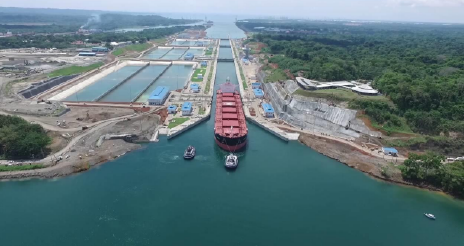- Our Mandate
- Mission and Objectives
- UNDRR in the UN
- Work Programme & Annual Reports
- Results Based System
- Work Partnerships
- Headquarters - Geneva
- SG-UN representatives for DRR
- Regional Office – The Americas and the Caribbean
- Head of the Regional Office – The Americas and the Caribbean
- What is Disaster Risk Reduction?
- What is the International Strategy?
- History of UNDRR
Americas thirst grows for resilient infrastructure
 Photo description: Agua Clara locks, Panama Canal. Photo Credits: The Panama Canal
Photo description: Agua Clara locks, Panama Canal. Photo Credits: The Panama Canal
By: Sophie Hares
PANAMA CITY, Panama, 11 October 2019 - When drought shrank the Panama Canal's water levels earlier this year, measures kicked in to limit the amount of cargo allowed through the 80- km-long waterway, maintaining trade flows while helping protecting fresh water supplies for nearby communities.
Increasingly extreme weather makes it harder to predict water levels for the canal which is conversely also at risk from severe storms and flooding, said Johnny Cuevas, head of water resources for the Panama Canal Authority, which runs regular flood evacuation drills for nearby villages.
"Climate change affects the Panama Canal very hard, in the rainy season it floods, in the dry season, we have evaporation," said Cuevas, noting the hunt is on for new water sources for the thirsty canal which lost $40 million in the 2015/16 El Nino drought.
"It's essential to safeguard the people and the integrity of the structure and infrastructure."
With more infrastructure expected to be thrown up over the next 20 years than over the past
2,000 years, ensuring new construction is resilient and built to withstand increasingly complex hazards is crucial, say experts.
Aside from costly new infrastructure, there is also an increasing need to retrofit higher-risk ageing structures, from bridges to hospitals and water supplies, to ensure they can stand the test as urban populations boom.
Reducing disaster damage to critical infrastructure and disruption of basic services - Target D of the Sendai Framework for Disaster Risk Reduction 2015-2030- will be the focus of the
UNDRR's International Day for Disaster Risk Reduction on October 13.
Hit by eight of the 10 costliest climate-related disasters between 1998 and 2017, the Americas is on the front line when it comes to extreme weather, ramping up the need to protect key infrastructure such as the Panama Canal that handles 5 percent of global trade.
However, in Latin America and the Caribbean, infrastructure investment has long-lagged, with knock-on effects on living standards and livelihoods. The Inter-American Development Bank says the region has an annual $150 billion infrastructure investment gap and the quality of infrastructure is often not up to scratch.
But there are bright spots.
PRICE TAG
Despite the destruction wrought by Hurricane Dorian as it ripped through the Bahamas in August, much of its critical infrastructure such as clinics and roads emerged relatively unscathed, said Ronald Jackson, executive director of the Caribbean Disaster Emergency Management Agency.
A strong adherence to building standards and codes helped protect public infrastructure in the Category 5 storm, said Jackson, while the devastation of entire neighbourhoods in Grand Abaco Island showed the high price paid by poor families who could not afford to strengthen their homes.
While more needs to be done to upgrade, protect and retrofit infrastructure, there are few cheap financing options for heavily-indebted Caribbean nations who are already struggling to cover their everyday costs, said Jackson.
Greener infrastructure such as renewable energy and micro-grids could help remote communities in particular become more resilient, but high initial start-up costs mean it remains out of reach for most, he added.
"There's definitely a focus on how green technologies can help to make these infrastructure areas
resilient," said Jackson.
"The challenge is how is it going to be financed given the current debt profile of the countries."
Given the hefty price tag on the resilient infrastructure of the future, there is growing pressure for governments to work closer with companies to help cover the cost.
The private sector is increasingly proactive and factoring future hazard levels into their investments, particularly when it comes to infrastructure, said Aris Papadopoulos, a global board member of the Private Sector Alliance for Disaster Resilient Societies, known as ARISE.
And companies have a vested interest. Resilient telecommunications, ports, roads and rail are essential to ensure supply chains remain intact and businesses bounce back quickly after a disaster, said Papadopoulos.
"The size of the problem, the complexity, is too big for any one group to address," he said.
"We want to make sure the new ínvestments beíng made are resí/íent, ít's a lot more economíc."
Landscapes vary but infrastructure is similar around the world which means broad solutions can often be applied, said Papadopoulos.
"We don't need to reínvent the wheel for every country, we can learn from each other," he added.
Follow the UNDRR news online :
 Now we have twitter account @UNDRR Américas y el Caribe
Now we have twitter account @UNDRR Américas y el Caribe
JOIN US!
Tweets por el @UNDRR Américas y el Caribe
